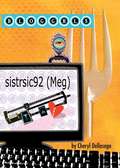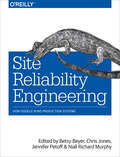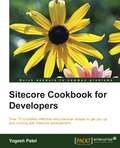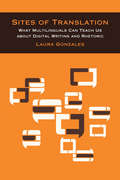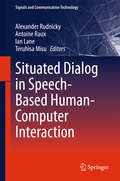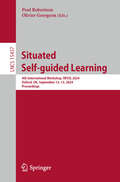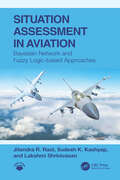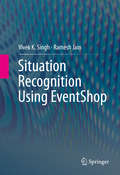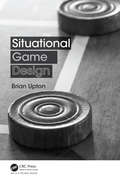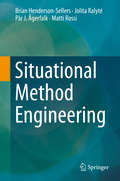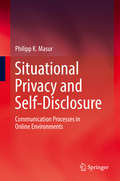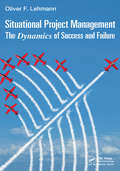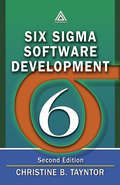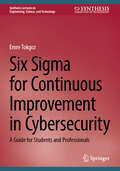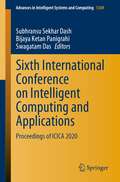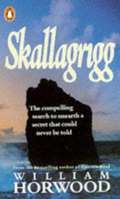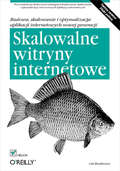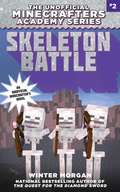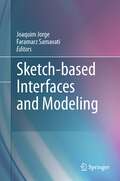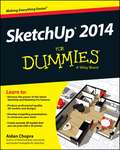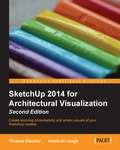- Table View
- List View
Sistrsic92 (Meg)
by Cheryl DellasegaMeg blogs about her perfect big sister, who has a big problem with food. As she tries to attract a boyfriend and deal with her beautiful but troubled half-sister, artistically talented high school sophomore Meg records her thoughts and feelings in a blog--accessible only to her three closest friends.
Site Automation: Automated/Robotic On-Site Factories (Cambridge handbooks in construction robotics vol. )
by Thomas Bock Thomas LinnerThe Cambridge Handbooks on Construction Robotics series focuses on the implementation of automation and robot technology to renew the construction industry and to arrest its declining productivity. The series is intended to give professionals, researchers, lecturers, and students basic conceptual and technical skills and implementation strategies to manage, research, or teach the implementation of advanced automation and robot-technology-based processes and technologies in construction. Currently, the implementation of modern developments in product structures (modularity and design for manufacturing), organizational strategies (just in time, just in sequence, and pulling production) and informational aspects (compute-aided design/manufacturing or computer-integrated manufacturing) are lagging because of the lack of modern integrated machine technology in construction. The Cambridge Handbooks on Construction Robotics books discuss progress in robot systems theory and demonstrate their integration using real systematic applications and projections for off-site as well as on-site building production. Logistics, Site Automation, and Robotics extends the new technology of robotics in building-component manufacturing and construction introduced in earlier volumes to on-site structured environments and on-site automated factories. This volume explores 30 different worldwide systems within a careful analytical framework in which the best conceptual features are extracted in order to help professionals and researchers develop new applications. The analytical approach splits the systems studies into a technical portion and a portion that focuses on parameters related to productivity, efficiency, and economic performance. A benefit of automated on-site factories is the integration of several stand-alone, single-task construction robots into structured on-site environments with networked machine systems to show improvements in on-site organization, integration, and material flow. Focuses on machine technology. A new interpretation of architecture and construction: from building 'construction' to building 'production'. Follows a cross disciplinary approach that relates traditional architectural and construction knowledge with the latest knowledge from manufacturing, automation and robot technology.
Site Reliability Engineering: How Google Runs Production Systems
by Chris Jones Niall Richard Murphy Betsy Beyer Jennifer PetoffThe overwhelming majority of a software systemâ??s lifespan is spent in use, not in design or implementation. So, why does conventional wisdom insist that software engineers focus primarily on the design and development of large-scale computing systems?In this collection of essays and articles, key members of Googleâ??s Site Reliability Team explain how and why their commitment to the entire lifecycle has enabled the company to successfully build, deploy, monitor, and maintain some of the largest software systems in the world. Youâ??ll learn the principles and practices that enable Google engineers to make systems more scalable, reliable, and efficientâ??lessons directly applicable to your organization.This book is divided into four sections:Introductionâ??Learn what site reliability engineering is and why it differs from conventional IT industry practicesPrinciplesâ??Examine the patterns, behaviors, and areas of concern that influence the work of a site reliability engineer (SRE)Practicesâ??Understand the theory and practice of an SREâ??s day-to-day work: building and operating large distributed computing systemsManagementâ??Explore Google's best practices for training, communication, and meetings that your organization can use
Sitecore Cookbook for Developers
by Yogesh PatelOver 70 incredibly effective and practical recipes to get you up and running with Sitecore development About This Book * Build enterprise-level rich websites quickly and deliver the best possible content management to your website * Get maximum usage of functionalities like different user interfaces, workflow, publishing, search, analytics, etc and learn different rendering techniques using presentation components for data bindings, events, handlers, schedulers, media, etc. * Add a surprising amount of functionality just by customizing the Sitecore architecture through the best practices contained in this book Who This Book Is For If you are a Sitecore developer or a programmer who wants to expand your Sitecore development skills, this book is ideal for you. You will need working knowledge of ASP.NET WebForms or MVC, as well as HTML, and a basic knowledge of Sitecore installation. What You Will Learn * Create, access, and personalize your website content using different Sitecore presentation components * Learn how to extend the presentation components to fulfill some real-life requiremnts such as improving the site's performance, generating Rss feeds and so on * Work with multiple websites on a single Sitecore instance and create multilingual websites * Customize the Sitecore interfaces as per your business requirements to provide easier and error-free user interface to content authors to save time and improve accuracy * Customize the Sitecore backend architecture as per your business needs * Automate tasks and achieve scalability by altering the development and configuration settings * Integrate external systems with Sitecore to import or export content and secure user interactions * Integrate the advanced features of analytics and personalization, to get the best possible customer experience and generate its reports In Detail This book will get you started on building rich websites, and customizing user interfaces by creating content management applications quickly. It will give you an insight into web designs and how to customize the Sitecore architecture as per your website's requirements using best practices. Packed with over 70 recipes to help you achieve and solve real-world common tasks, requirements, and the problems of content management, content delivery, and publishing instance environments. It also presents recipes on Sitecore's backend processes of customizing pipelines, creating custom event handler and media handler, setting hooks to interpret foreign language URL and more. Other topics covered include creating a workflow action, publishing sublayouts and media files, securing your environment by customizing user profiles and access rights, boosting search capabilities, optimising performance, scalability and high-availability of Sitecore instances and much more. By the end of this book, you will have be able to add virtually limitless features to your websites by developing and deploying Sitecore efficiently. Style and approach This easy-to-follow guide is full of hands-on recipes on real-world development tasks to improve your existing Sitecore system. Each topic is presented with its benefits and detailed steps to achieve it through well-explained code and images.
Sites of Translation: What Multilinguals Can Teach Us about Digital Writing and Rhetoric (Sweetland Digital Rhetoric Collaborative)
by Laura GonzalesWinner of the 2016 Sweetland Digital Rhetoric Collaborative Book Prize Sites of Translation illustrates the intricate rhetorical work that multilingual communicators engage in as they translate information for their communities. Blending ethnographic and empirical methods from multiple disciplines, Laura Gonzales provides methodological examples of how linguistic diversity can be studied in practice, both in and outside the classroom, and provides insights into the rhetorical labor that is often unacknowledged and made invisible in multilingual communication. Sites of Translation is relevant to researchers and teachers of writing as well as technology designers interested in creating systems, pedagogies, and platforms that will be more accessible and useful to multilingual audiences. Gonzales presents multilingual communication as intellectual labor that should be further valued in both academic and professional spaces, and supported by multilingual technologies and pedagogies that center the expertise of linguistically diverse communicators.
Situated Dialog in Speech-Based Human-Computer Interaction
by Alexander Rudnicky Antoine Raux Ian Lane Teruhisa MisuThis book provides a survey of the state-of-the-art in the practical implementation of Spoken Dialog Systems for applications in everyday settings. It includes contributions on key topics in situated dialog interaction from a number of leading researchers and offers a broad spectrum of perspectives on research and development in the area. In particular, it presents applications in robotics, knowledge access and communication and covers the following topics: dialog for interacting with robots; language understanding and generation; dialog architectures and modeling; core technologies; and the analysis of human discourse and interaction. The contributions are adapted and expanded contributions from the 2014 International Workshop on Spoken Dialog Systems (IWSDS 2014), where researchers and developers from industry and academia alike met to discuss and compare their implementation experiences, analyses and empirical findings.
Situated Listening: Attending to the Unheard (Sound Design)
by Morten Søndergaard Stephanie Loveless Tullis Rennie Freya ZinovieffGrounded in a conviction that how we listen matters deeply in the context of ongoing social, political, and ecological crises, Situated Listening: Attending to the Unheard sets forth a collection of methodologies and creative proposals for listening, advancing the framework of situated listening as both a theoretical concept and a methodological practice that investigates relationships between the listening body and the politics of place, space, and culture.Drawing from an array of scholarship that engages sound studies broadly, this 15-chapter book is written entirely collaboratively and from a multidisciplinary perspective. Each section includes scores for situated listening, which take the form of diagrams, instructions, exercises, images, and meditations. The scores offer alternate modes of sharing the central ideas of the associated chapters, inviting the reader to shift from theory into practice. This book contributes to decolonial, feminist, anti-racist, and anti-capitalist scholarship in the field of sound studies, by centering listening as a relational practice.This book brings together a roster of accomplished, international contributors, making it essential supplementary reading for advanced undergraduates and researchers in sound studies. It will be of interest to faculty and students in the fields of Sound Studies, Music, Feminist Science and Technology Studies, Urban Design, and Sound Art.
Situated Self-guided Learning: 4th International Workshop, IWSSL 2024, Oxford, UK, September 12–13, 2024, Proceedings (Lecture Notes in Computer Science #15457)
by Paul Robertson Olivier GeorgeonThis book constitutes the refereed proceedings of the 4th International Workshop on Situated Self-Guided Learning, IWSSL 2024, held in Oxford, UK, during September 12–13, 2024. The 6 papers presented in this book were carefully reviewed and selected from 7 submissions. The workshop was invitation only, which guaranteed high caliber attendees.
Situation Assessment in Aviation: Bayesian Network and Fuzzy Logic-based Approaches
by Jitendra R. Raol Sudesh K. Kashyap Lakshmi ShrinivasanSituation Assessment in Aviation focuses on new aspects of soft computing technologies for the evaluation and assessment of situations in aviation scenarios. It considers technologies emerging from multisensory data fusion (MSDF), Bayesian networks (BN), and fuzzy logic (FL) to assist pilots in their decision-making.Studying MSDF, BN, and FL from the perspective of their applications to the problem of situation assessment, the book discusses the development of certain soft technologies that can be further used for devising more sophisticated technologies for a pilot's decision-making when performing certain tasks: airplane monitoring, pair formation, attack, and threat. It explains the concepts of situation awareness, data fusion, decision fusion, Bayesian networks, fuzzy logic type 1, and interval type 2 fuzzy logic. The book also presents a hybrid technique by using BN and FL and a unique approach to the problem of situation assessment, beyond visual range and air-to-air combat, by utilizing building blocks of artificial intelligence (AI) for the future development of more advanced automated systems, especially using commercial software.The book is intended for aerospace R&D engineers, systems engineers, aeronautical engineers, and aviation training professionals. It will also be useful for aerospace and electrical engineering students taking courses in Air Traffic Management, Aviation Management, Aviation Operations, and Aviation Safety Systems.
Situation Recognition Using EventShop
by Ramesh Jain Vivek K. SinghThis book presents a framework for converting multitudes of data streams available today including weather patterns, stock prices, social media, traffic information, and disease incidents into actionable insights based on situation recognition. It computationally defines the notion of situations as an abstraction of millions of data points into actionable insights, describes a computational framework to model and evaluate such situations and presents an open-source web-based system called EventShop to implement them without necessitating programming expertise. The book is useful for both practitioners and researchers working in the field of situation-aware computing. It acts as a primer for data-enthusiasts and information professionals interested in harnessing the value of heterogeneous big data for building diverse situation-based applications. It also can be used as a reference text by researchers working in areas as varied as database design, multimodel concept recognition, and middle-ware and ubiquitous computing to design and develop frameworks that allow users to create their own situation recognition frameworks.
Situational Game Design
by Brian UptonSituational Design lays out a new methodology for designing and critiquing videogames. While most game design books focus on games as formal systems, Situational Design concentrates squarely on player experience. It looks at how playfulness is not a property of a game considered in isolation, but rather the result of the intersection of a game with an appropriate player. Starting from simple concepts, the book advances step-by-step to build up a set of practical tools for designing player-centric playful situations. While these tools provide a fresh perspective on familiar design challenges as well as those overlooked by more transactional design paradigms. Key Features Introduces a new methodology of game design that concentrates on moment-to-moment player experience Provides practical design heuristics for designing playful situations in all types of games Offers groundbreaking techniques for designing non-interactive play spaces Teaches designers how to create games that function as performances Provides a roadmap for the evolution of games as an art form.
Situational Method Engineering
by Pär J. Ågerfalk Brian Henderson-Sellers Jolita Ralyté Matti RossiWhile previously available methodologies for software - like those published in the early days of object technology - claimed to be appropriate for every conceivable project, situational method engineering (SME) acknowledges that most projects typically have individual characteristics and situations. Thus, finding the most effective methodology for a particular project needs specific tailoring to that situation. Such a tailored software development methodology needs to take into account all the bits and pieces needed for an organization to develop software, including the software process, the input and output work products, the people involved, the languages used to describe requirements, design, code, and eventually also measures of success or failure. The authors have structured the book into three parts. Part I deals with all the basic concepts, terminology and overall ideas underpinning situational method engineering. As a summary of this part, they present a formal meta-model that enables readers to create their own quality methods and supporting tools. In Part II, they explain how to implement SME in practice, i. e. , how to find method components and put them together and how to evaluate the resulting method. For illustration, they also include several industry case studies of customized or constructed processes, highlighting the impact that high-quality engineered methods can have on the success of an industrial software development. Finally, Part III summarizes some of the more recent and forward-looking ideas. This book presents the first summary of the state of the art for SME. For academics, it provides a comprehensive conceptual framework and discusses new research areas. For lecturers, thanks to its step-by-step explanations from basics to the customization and quality assessment of constructed methods, it serves as a solid basis for comprehensive courses on the topic. For industry methodologists, it offers a reference guide on features and technologies to consider when developing in-house software development methods or customising and adopting off-the-shelf ones.
Situational Privacy and Self-Disclosure: Communication Processes in Online Environments
by Philipp K. MasurUsing both a theoretical argumentation and an empirical investigation, this book rationalizes the view that in order to understand people’s privacy perceptions and behaviors, a situational perspective needs to be adopted.To this end, the book is divided into three parts. Part I advances the theory of situational privacy and self-disclosure by discussing impacts of new information and communication technologies on traditional theories of privacy and self-disclosure. Based on five basic suppositions, it describes three major processes of the theory: pre-situational privacy regulations processes, situational privacy perception and self-disclosure processes, and post-situational evaluation processes. Next, Part II presents the application of the theory to smartphone-based communication. It first analyses how people choose certain communication environments on their smartphones, how they manipulate them, and how these external factors affect self-disclosure within these environments. It then details a multi-method study conducted to test the derived assumptions and discusses the obtained results. Part III reflects on the overall implications of the theory, summarizes the major findings and lastly considers possible extensions and perspectives on future research.Intended mainly for researchers in privacy and communication studies, the book offers privacy scholars a systematic review of both classic and contemporary theories of privacy and self-disclosure. At the same time, communication scholars benefit from an additional methodological discussion of the mobile experience sampling method, which provides an invaluable approach to measuring situational communication processes.
Situational Project Management: The Dynamics of Success and Failure (Best Practices in Portfolio, Program, and Project Management)
by Oliver F. LehmannMost project managers would agree that every project is unique. But not all project managers would agree that the best way to manage a unique project is unique. Many still cling to the old practice of having a methodology that is applied to all projects. "One size fits all" is still in common use, and this approach has proven to lead to project failure. Flexibility, situational intelligence, and creativity are essential to deliver project success. The need to recognize and master ever-changing requirements and environmental conditions is a tough challenge for professional project managers. The same practices that led to success yesterday may cause failure today. Selecting favorable responses to a given situation is often the most critical factor of the dynamics of success and failure. This book is designed to help project professionals assess a situation, predict the appropriate approach, methodology and achieving styles, and then apply them in a situational fashion. To guide project managers in selecting the appropriate responses, Situational Project Management (SitPM) shows how to assess a given project, determine its unique characteristics, and select the appropriate methods to complete the project. With this book, projects managers can use SitPM to develop profiles of their projects on the basis of the projects’ physical characteristics, the project teams’ behavioral characteristics, the enterprise environment, and the market environments receiving project deliverables. These profiles help project managers to determine the appropriate project life cycle approach and leadership style. The book also explores various ways to engage stakeholders on the basis of a project’s SitPM profile. The book’s author, Oliver F. Lehmann, has developed a set of templates to apply SitPM in practice. It can be downloaded from www.oliverlehmann.com/SitPM/Templates.zip.
Six Billion Shoppers: The Companies Winning the Global E-Commerce Boom
by Porter ErismanAn insightful, practical guide to e-commerce in emerging markets--and how to profit from their explosive boom.From China to India to Nigeria, e-commerce is entering a golden era in countries that were long left out of the e-commerce gold rush experienced in the West. If the story of the first twenty years of e-commerce’s growth was set in developed markets, the story of the next twenty years will be set in emerging ones. The rise of e-commerce in emerging markets is being driven by three major trends: widespread internet adoption, a rising middle class, and, most importantly, innovative new business models that serve the needs of local customers better than the models used by western e-commerce giants.Six Billion Shoppers takes readers on an exciting and colorful journey around the world to visit the next e-commerce mega markets and explore how a new e-commerce boom is opening opportunities for entrepreneurs and global brands alike. Traveling through Nigeria, China, India, Southeast Asia, and Latin America, Porter Erisman addresses e-commerce across these new markets and what it means for western brands. He argues that e-commerce in developing countries is revolutionary and will play a much larger role in emerging markets than in the West. With e-commerce in emerging markets entering a rapid period of expansion, Six Billion Shoppers explains how to seize the massive opportunity created by emerging market consumers and provides practical advice on how to ride this new business trend.
Six Sigma Software Development
by Christine B. TayntorEven though Six Sigma programs have successfully been implemented in practice, many IT departments remain skeptical of the process or are unaware of how the tools can be used to improve system development. Removing the mystique surrounding this technique, Six Sigma Software Development, Second Edition demonstrates how Six Sigma tools and concepts c
Six Sigma for Continuous Improvement in Cybersecurity: A Guide for Students and Professionals (Synthesis Lectures on Engineering, Science, and Technology)
by Emre TokgozThis textbook is designed to teach students and practitioners how to integrate Six Sigma techniques with cybersecurity applications, specifically in training current and future cybersecurity professionals. It utilizes the DMAIC process (Define, Measure, Analyze, Improve, and Control) to strengthen cybersecurity defenses against cyber-attacks while reducing costs and waste. Recognizing that Six Sigma training requires a solid understanding of statistics and technology for effective data analysis, the book covers relevant statistical concepts along with essential Six Sigma, Lean, quality, and technology principles. These are crucial for readers to understand, adopt, and implement continuous improvement strategies in the workplace, ultimately making them a part of their cybersecurity project management culture. This book is suitable for undergraduate courses, depending on the curriculum's specific statistics and technology requirements. It can also serve as a Six Sigma certificate training resource for professionals in the field.
Sixth International Conference on Intelligent Computing and Applications: Proceedings of ICICA 2020 (Advances in Intelligent Systems and Computing #1369)
by Bijaya Ketan Panigrahi Swagatam Das Subhransu Sekhar DashThis book presents the peer-reviewed proceedings of the Sixth International Conference on Intelligent Computing and Applications (ICICA 2020), held at Government College of Engineering, Keonjhar, Odisha, India, during December 22–24, 2020. The book includes the latest research on advanced computational methodologies such as neural networks, fuzzy systems, evolutionary algorithms, hybrid intelligent systems, uncertain reasoning techniques, and other machine learning methods and their applications to decision-making and problem-solving in mobile and wireless communication networks.
Skalierung von KI im Marketing und die neue Rolle des CMO (Science meets Practice)
by Marko Sarstedt Bernhard WeckeDie Einführung und insbesondere die Skalierung von KI erfordert sowohl im Marketing als auch im Gesamtunternehmen einen grundlegenden Veränderungsprozess. Damit dieser gelingen kann, müssen der organisatorische Rahmen und in der Folge die Ablauf- und Aufbauorganisation angepasst werden. Zudem muss der CMO einen pragmatischen Weg finden, erste Erfahrungen beim Einsatz von KI zu gewinnen und mit Hilfe der daraus abgeleiteten Erkenntnisse, den Transformationsprozess im Gesamtunternehmen zu unterstützen. In diesem Band der Reihe "Science meets Practice" werden die wesentlichen Handlungsfelder für einen CMO wie die Gestaltung der KI-Narrative, des KI-Organismus sowie der KI-Kompetenzen erläutert.Video per App: einfach die SN More Media App kostenfrei herunterladen, einen Link mit dem Play-Button scannen und sofort das Video auf Smartphone oder Tablet ausspielen.Der InhaltBeschreibung der neuen Rahmenbedingungen des Marketings, bedingt durch Markt, Wettbewerb und TechnologieEinführung in das Konzept der KIDiskussion von Barrieren und Erfolgsfaktoren bei der Adaption von KIBeschreibung eines Gestaltungsrahmens für die Neuausrichtung der Ablauf- und Aufbauorganisation im Marketing in einer KI-geprägten UmweltKonkrete Handlungsempfehlungen für die Einführung von KI in Ihrer Marketingorganisation Videos mit Experteninterviews
Skallagrigg
by William HorwoodThis story takes place in England, spanning the late 1800s to the not-too-distant future. One layer is the search for the "Skallagrigg", a mythical being known only to institutionalized disabled people. Are Arthur, a lttle boy with cerebral palsy who was left in a grim asylum, and the Skallagrigg merely myth? Read and find out. And then there's Esther Marquand, many years later, who as a woman with spastic cerebral palsy, cannot talk nor move much on her own. Yet she learns computers and writes amazing programming. SDhe goers in search of the Skallagrigg and makes her search into a computer game. Then there are all the other characters, including Tom, the close friend with Downs Syndrome. There are romances and losses. Surprises. Tears of sadness and joy. This is a good clean copy, I have verified accuracy with another person against the print book, but I'm not sure how screenreaders will come through on some of the phonetic disabled speech.
Skalowalne witryny internetowe. Budowa, skalowanie i optymalizacja aplikacji internetowych nowej generacji
by Cal HendersonNaucz si? tworzy? aplikacje internetowe nowej generacji i do?šcz do nurtu Web 2.0 Chcesz tworzy? bardziej wydajne aplikacje internetowe? Chcesz pozna? zasady projektowania skalowalnych architektur? Chcesz efektywnie zarzšdza? danymi w aplikacjach internetowych? Oblicze internetu podlega nieustannym zmianom. Obecnie coraz cz??ciej obok klasycznych witryn internetowych pojawiajš si? aplikacje internetowe, które charakteryzujš si? odseparowaniem warstwy danych od warstwy prezentacji. Zmiana modelu programowania wymaga przygotowania odpowiedniej platformy sprz?towej i programowej oraz zaprojektowania nowego systemu obs?ugi danych. Zastosowanie przy wykonywaniu tych zada? sprawdzonych strategii wykorzystywanych przez pionierów tworzšcych aplikacje internetowe nowej generacji pozwoli Ci zaoszcz?dzi? czas i koszty. Ksiš?ka "Skalowalne witryny internetowe..." to zaawansowany i wszechstronny przeglšd zagadnie? zwišzanych z budowaniem takich w?a?nie aplikacji internetowych. Pomo?e Ci ona w rozwišzaniu problemów i unikni?ciu pu?apek czyhajšcych na programistów witryn internetowych nowej generacji. Poznasz sprawdzone strategie projektowania architektury oprogramowania, przygotowywania ?rodowiska programistycznego, zapewniania niezawodno?ci aplikacji czy wydajnego zarzšdzania informacjami. Dowiesz si? tak?e, jak tworzy? skalowalne i ?atwe w konserwacji witryny, które b?dš zapewnia? komfort pracy niezale?nie od up?ywu czasu i wzrostu liczby u?ytkowników. Projektowanie architektury aplikacji internetowych Przygotowywanie ?rodowiska programistycznego Tworzenie aplikacji wieloj?zycznych Zarzšdzanie bazami danych Integrowanie poczty elektronicznej z witrynami Stosowanie us?ug zdalnych Wykrywanie i rozwišzywanie problemów z wydajno?ciš Skalowanie aplikacji internetowych Monitorowanie funkcjonowania aplikacji Korzystanie z interfejsów API
Skeleton Battle (The Unofficial Minecrafters Academy Series #2)
by Winter MorganAfter a scourge of griefer attacks and a change in headmasters, Minecrafters Academy is once again at peace, and Lucy is working hard to keep up in all her classes. Meanwhile, the school is gearing up for an end-of-the-year talent show, where everyone will showcase their greatest skills, from master building and clever potion-making to strategic fighting.But when a hoard of skeletons and hostile mobs attacks the campus one night, an all-too-familiar struggle begins. Is Isaac, the school’s evil former headmaster, behind the attacks? Lucy and her friends are determined to get to the bottom of the mystery and keep their school safe. As the attacks continue and their search for clues turns up more enemies than friends, Lucy, Jane, and Phoebe must rely on each other to survive-and find a way to save the school.Fans of Minecraft and magic academies won’t want to miss the latest adventure in the Unofficial Minecrafters Academy series.Sky Pony Press, with our Good Books, Racehorse and Arcade imprints, is proud to publish a broad range of books for young readers-picture books for small children, chapter books, books for middle grade readers, and novels for young adults. Our list includes bestsellers for children who love to play Minecraft; stories told with LEGO bricks; books that teach lessons about tolerance, patience, and the environment, and much more. In particular, this adventure series is created especially for readers who love the fight of good vs. evil, magical academies like Hogwarts in the Harry Potter saga, and games like Minecraft, Terraria, and Pokemon GO. While not every title we publish becomes a New York Times bestseller or a national bestseller, we are committed to books on subjects that are sometimes overlooked and to authors whose work might not otherwise find a home.
Sketch-based Interfaces and Modeling
by Joaquim Jorge Faramarz SamavatiThe field of sketch-based interfaces and modeling (SBIM) is concerned with developing methods and techniques to enable users to interact with a computer through sketching - a simple, yet highly expressive medium. SBIM blends concepts from computer graphics, human-computer interaction, artificial intelligence, and machine learning. Recent improvements in hardware, coupled with new machine learning techniques for more accurate recognition, and more robust depth inferencing techniques for sketch-based modeling, have resulted in an explosion of both sketch-based interfaces and pen-based computing devices. Presenting the first coherent, unified overview of SBIM, this unique text/reference bridges the two complementary research areas of user interaction (sketch-based interfaces), and graphical modeling and construction (sketch-based modeling). The book discusses the state of the art of this rapidly evolving field, with contributions from an international selection of experts. Also covered are sketch-based systems that allow the user to manipulate and edit existing data - from text, images, 3D shapes, and video - as opposed to modeling from scratch. Topics and features: reviews pen/stylus interfaces to graphical applications that avoid reliance on user interface modes; describes systems for diagrammatic sketch recognition, mathematical sketching, and sketch-based retrieval of vector drawings; examines pen-based user interfaces for engineering and educational applications; presents a set of techniques for sketch recognition that rely strictly on spatial information; introduces the Teddy system; a pioneering sketching interface for designing free-form 3D models; investigates a range of advanced sketch-based systems for modeling and designing 3D objects, including complex contours, clothing, and hair-styles; explores methods for modeling from just a single sketch or using only a few strokes. This text is an essential resource for researchers, practitioners and graduate students involved in human-factors and user interfaces, interactive computer graphics, and intelligent user interfaces and AI.
SketchUp 2014 For Dummies
by Aidan ChopraStart building your 3D model today with a comprehensive guide to SketchUp 2014SketchUp 2014 For Dummies is a user-friendly guide to creating 3D models, adding textures, creating animated walkthroughs, and more, using one of the most popular 3D modeling programs on the market. Fully updated to align with the release of SketchUp, the book guides you through the interface, tools, techniques, and tricks in SketchUp and SketchUp Pro, on both Windows and Mac platforms. Written for designers with no prior 3D modeling experience, the book provides beginner- to intermediate-level instruction in this powerful program.With a strong emphasis on usability rather than features, SketchUp has found widespread success around the world. Available as a free download, the program allows you to get comfortable and develop your skills before investing in the Pro version's additional features. SketchUp 2014 For Dummies gets you up to speed fast, beginning with an overview of the basic concepts of 3D modeling before getting down to business with the software. Organized for easy navigation, the book can also serve as a handy desk reference for more experienced designers getting acquainted with the latest update. Topics include:Using SketchUp 2014 to create 3D modelsPrinting on a plotter or 3D printerSharing designs via SketchUp 3D WarehouseExporting to another design packageThe book also walks you through the creation of a detailed set of plans, and demonstrates how to give virtual "tours" of your design. A 16-page color insert illustrates the possibilities, and may just trigger your inspiration. Whether you're a designer, architect, engineer, or hobbyist, SketchUp 2014 For Dummies gets you started quickly.
SketchUp 2014 for Architectural Visualization Second Edition
by Robin De Jongh Thomas BleicherBeginning with a quick start tutorial which will get you up and running with SketchUp 2014 quickly, you will move on to learning the key skills you will need to wow your clients with stunning visualizations through a series practical steps, tips and tricks. If you are a SketchUp user, from an amateur right through to an architectural technician, professional architect, or designer, this is the book for you. This book is also suitable as a companion to any architectural design or multimedia course, and is accessible to anyone who has learned the basics of SketchUp.
